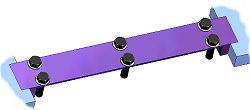Duplicate one or more components and arrange the resulting occurrences in a circular or rectangular pattern.
Duplicates one or more components and arranges the resulting occurrences in a circular or rectangular pattern. Rectangular and circular patterns can use patterned features on a part to set number and spacing.

- Create a circular pattern by specifying the number of components and the angle between them.
- Create a rectangular pattern by specifying column and row spacing.
- Create associative circular and rectangular patterns by matching features patterned on a part.
By matching the assembly pattern to the arrangement and spacing of part features, you can make the pattern associative. Changes to the part feature pattern can add or remove components in the assembly pattern.
How are patterns incorporated into assembly workflows?
You can create an assembly pattern at any time after a component is added to the assembly. After you add a component to an assembly, you can:
- Select the component and copy it into a pattern.
- Associate the assembly pattern to a part feature pattern. Changes to the part feature pattern can add or remove components in the assembly pattern.
What actions can I perform on assembly patterns?
Pattern elements are the members in an assembly pattern. Element contain one or more component instances that are added to an assembly when a pattern is completed. For example, a rectangular pattern can include six bolts and washers in three rows of two each. Six elements, each containing one instance of the bolt and one instance of the washer, are added to the assembly when the pattern is completed.
Pattern elements are listed in the browser under the assembly pattern icon. When expanded, the instances can be acted upon like any other instance in the assembly. You can:
- Edit pattern instances in the assembly context (effects all components in the pattern).
- Turn visibility on and off for pattern instances or the entire assembly pattern.
- Show results of an appearance override, such as color (effects only the selected pattern instance).
- Constrain pattern instances to a part that is not included in the pattern.
- Suppress pattern elements.
- Replace all instances within a pattern.
You can right-click the component pattern icon in the browser to edit, delete, create a note, promote and demote (if applicable), and turn visibility off and on for the entire pattern. You can make elements independent of the pattern and restore them.
What can I include in assembly patterns?
Component patterns can be:
- Associative to a part feature. If you edit the part or add or remove from the part pattern, a corresponding result occurs automatically in the assembly.
- Considered as an assembly object with characteristics unlike singly placed components. For example, you can expand an individual assembly pattern element in the browser. Then (like a subassembly) activate and edit a component instance in the pattern element.
- Included in another component pattern. An example is to create a pattern of fasteners around a component. Then create a pattern consisting of the component and the pattern of fasteners.
Can pattern elements be made independent of patterns?
You can select one or more nonsource pattern elements in the browser, right-click, and then choose Independent to sever their link to the pattern. When you make an element independent:
- The selected pattern element is suppressed.
- A copy of each component instance contained within the element is placed in the same position and orientation as the suppressed element.
- The new components are listed independently above the pattern node in the browser hierarchy.
- A browser symbol indicates that the link to the pattern is broken.
- A pattern of a pattern cannot have independent elements.
You can restore an independent element to the pattern, but the copied components created when the element was made independent are not automatically deleted. For example, if you make Element:2 independent and it contains screw:2, a browser symbol appears. The symbol indicates that the link to the pattern is severed, and screw:2 is copied above the pattern node in the browser hierarchy. When Element:2 is restored, the copy of screw:2 remains above the pattern in the browser.
What are some tips used to manage component patterns?
These tips help you achieve good results when working with component patterns. For example:
- You can select a range of pattern elements in the browser. Only the elements that are expanded are selected.
- Assure that all elements of a pattern update properly when matched to a part feature pattern. Constrain the source of the component pattern (the first element) to the feature pattern.
- If restoring an independent element to the pattern, move or delete the copies of its components to avoid having two parts coincident with one another.
Patterns can be made associative to a part feature pattern so that changes to the pattern add to or subtract components in the assembly pattern. Individual or all occurrences can have visibility turned on or off.
If included in a pattern, relationships or iMates are retained whenever possible.